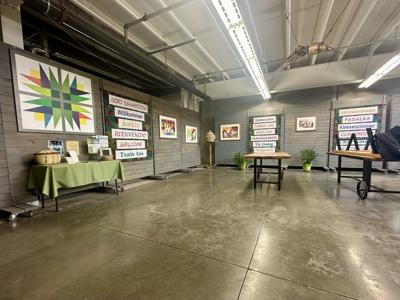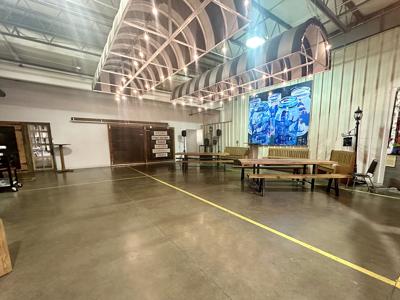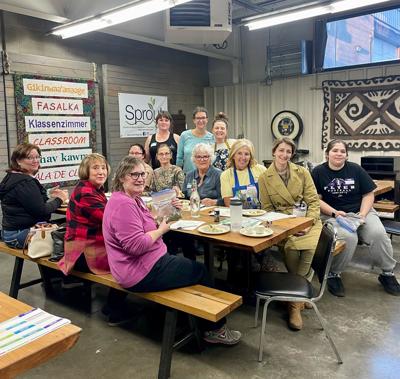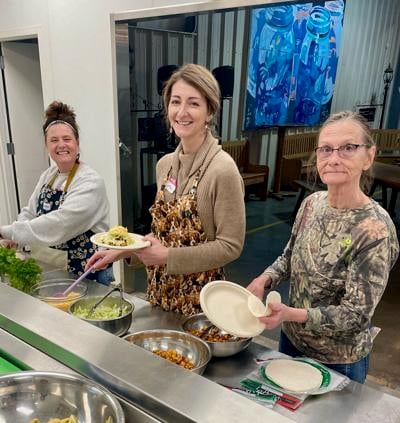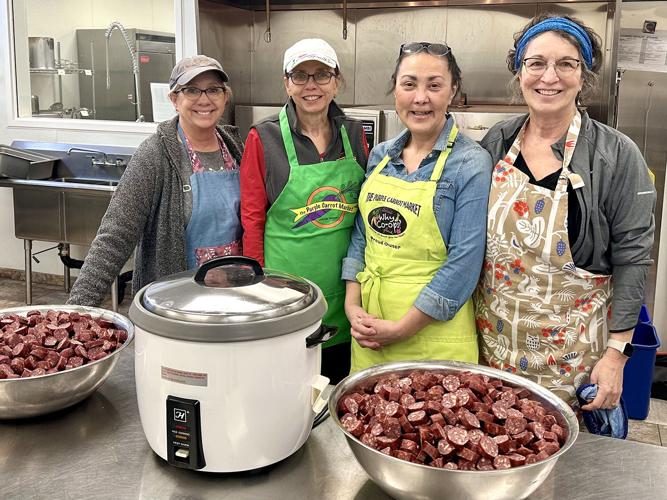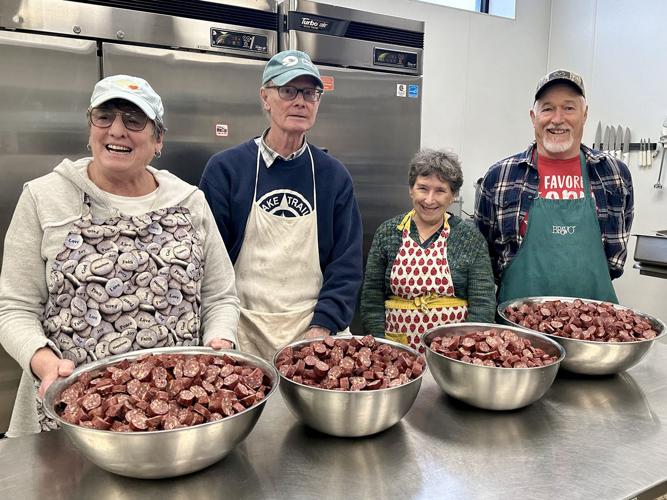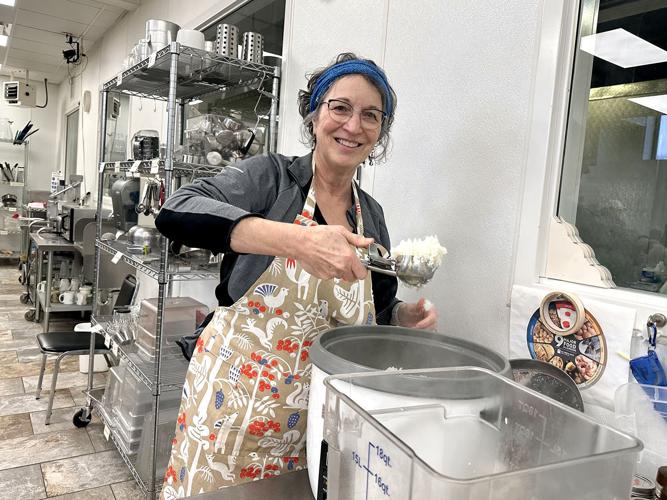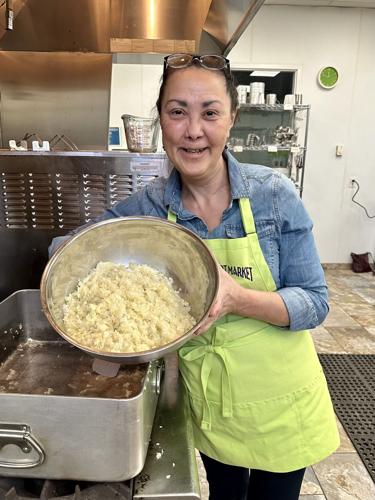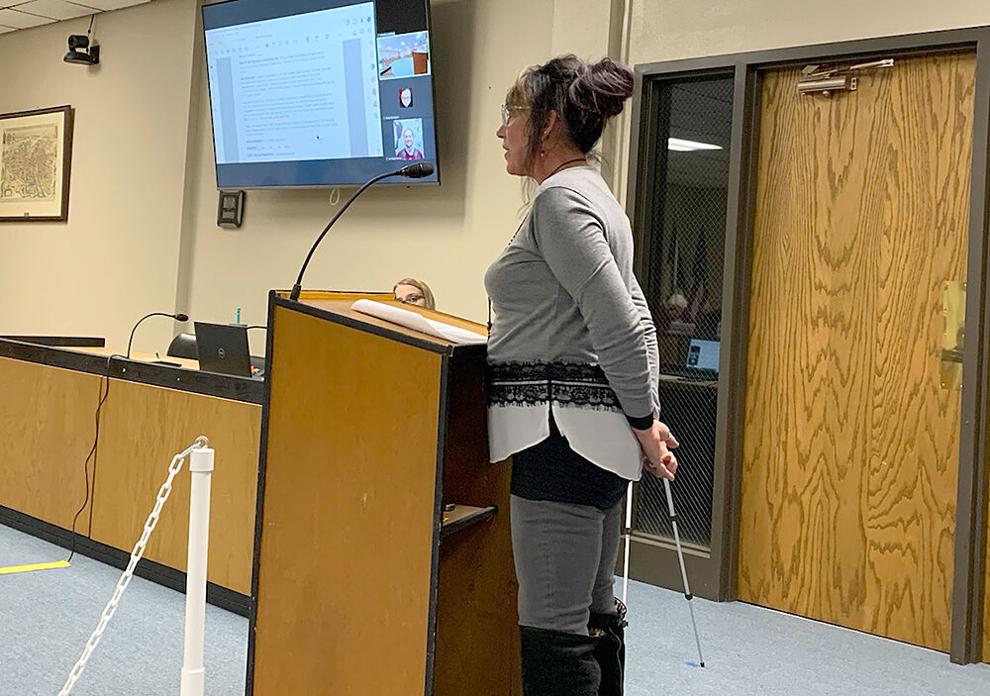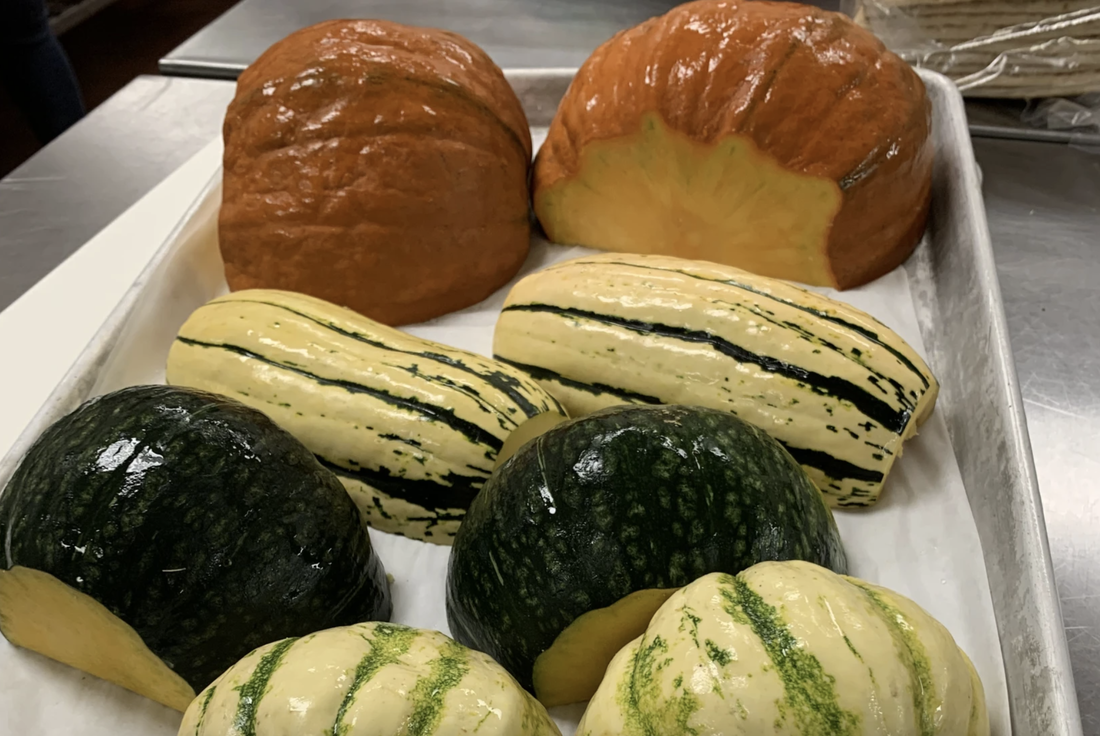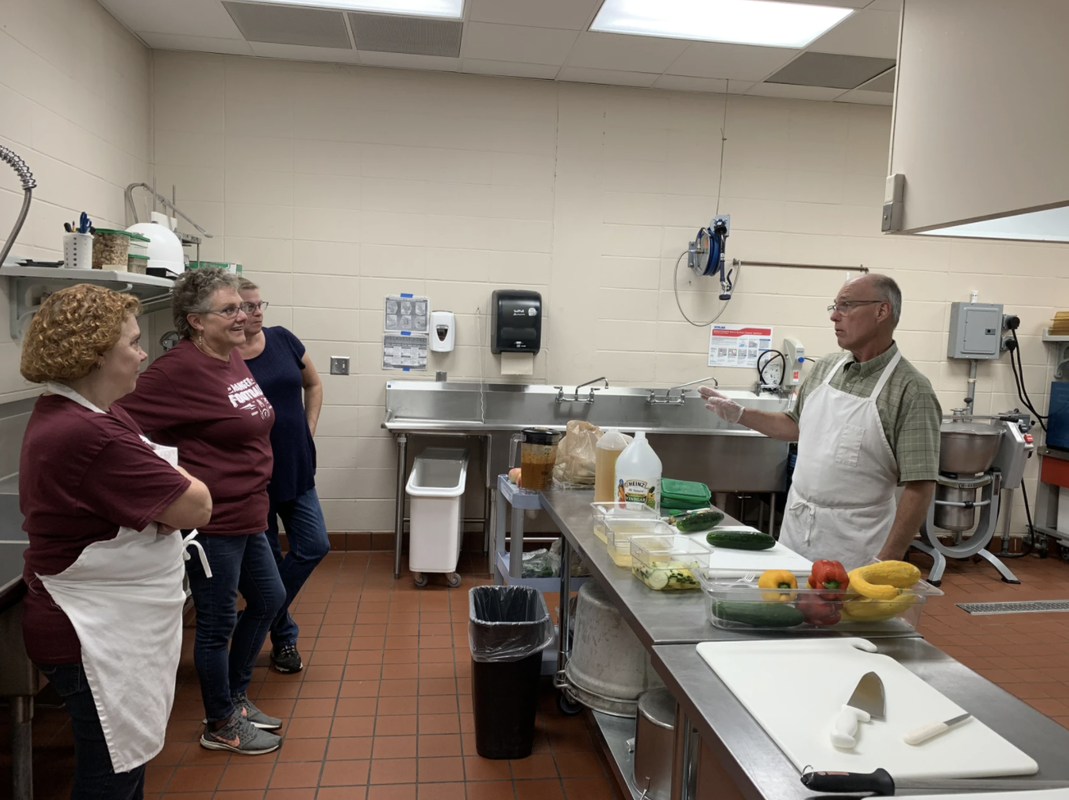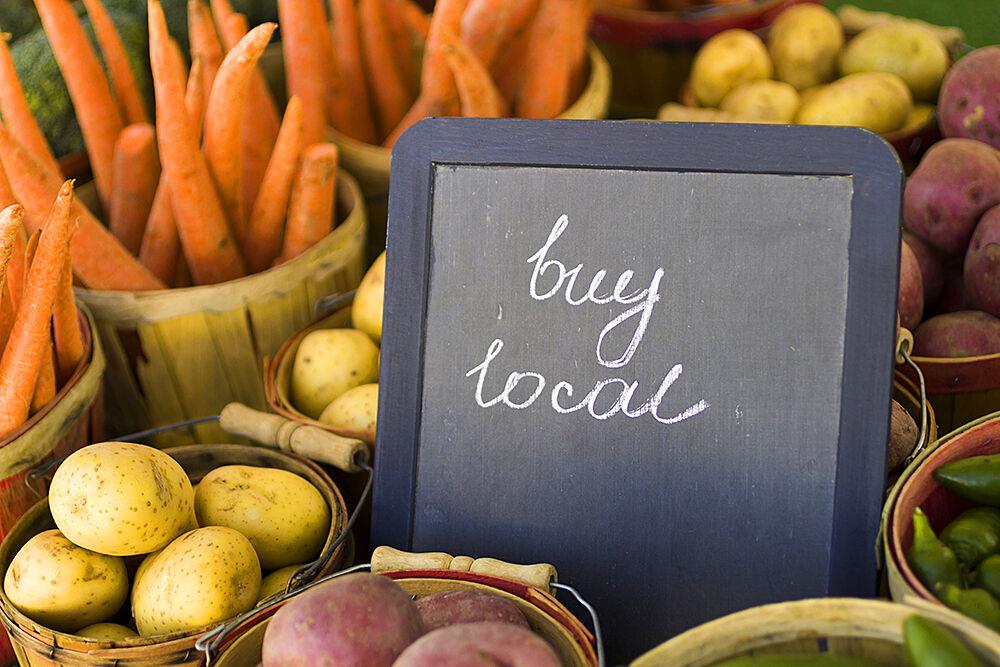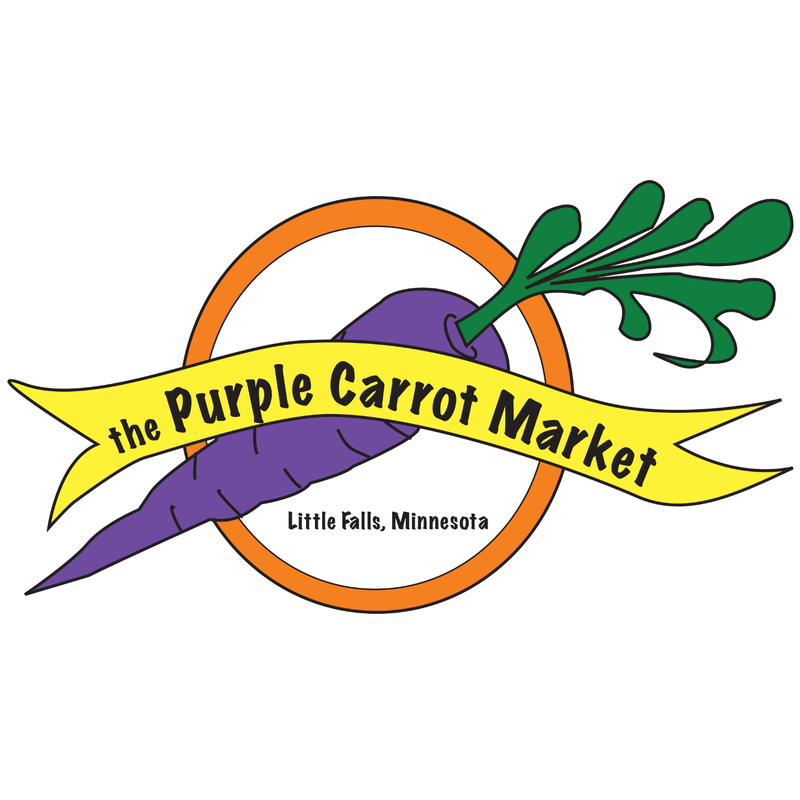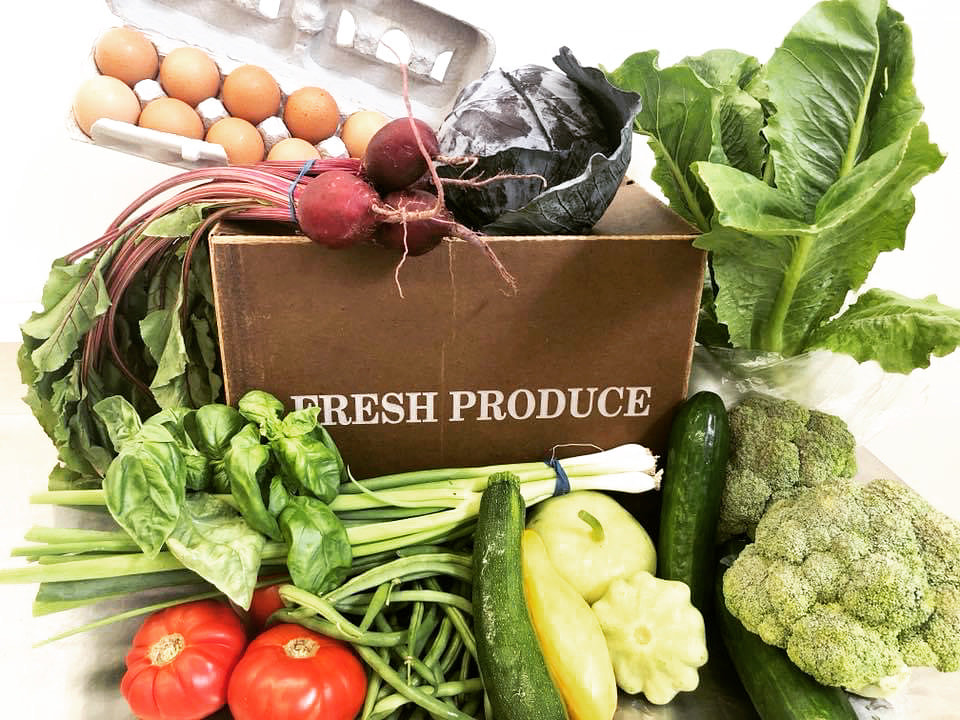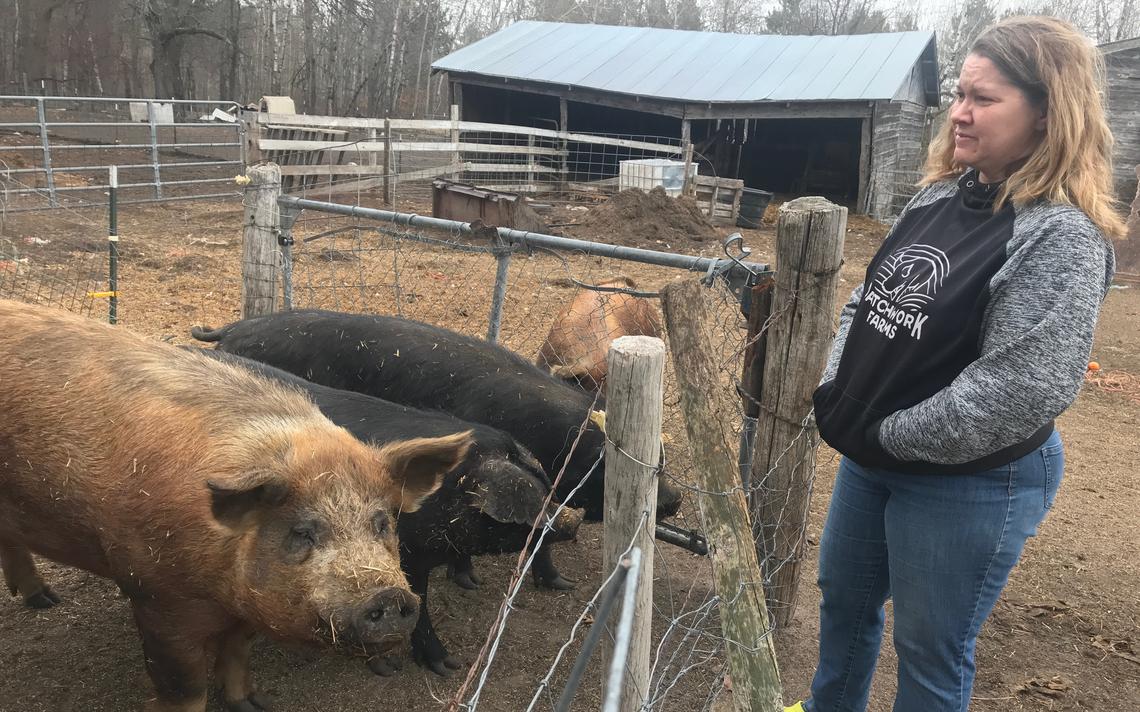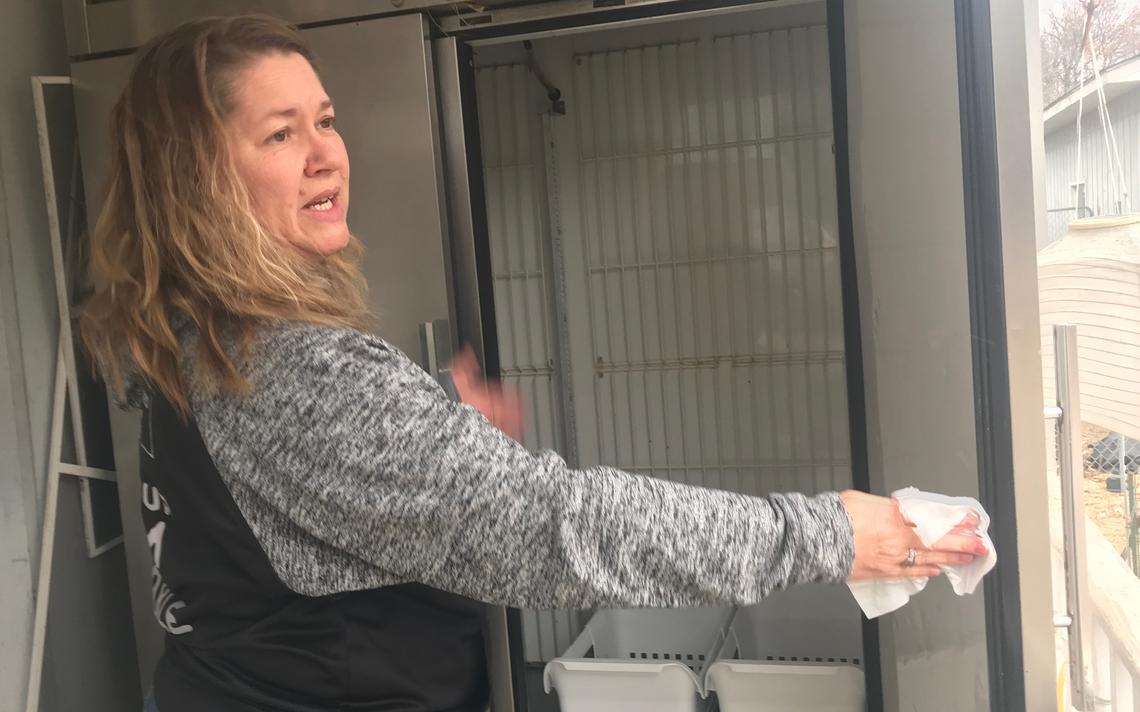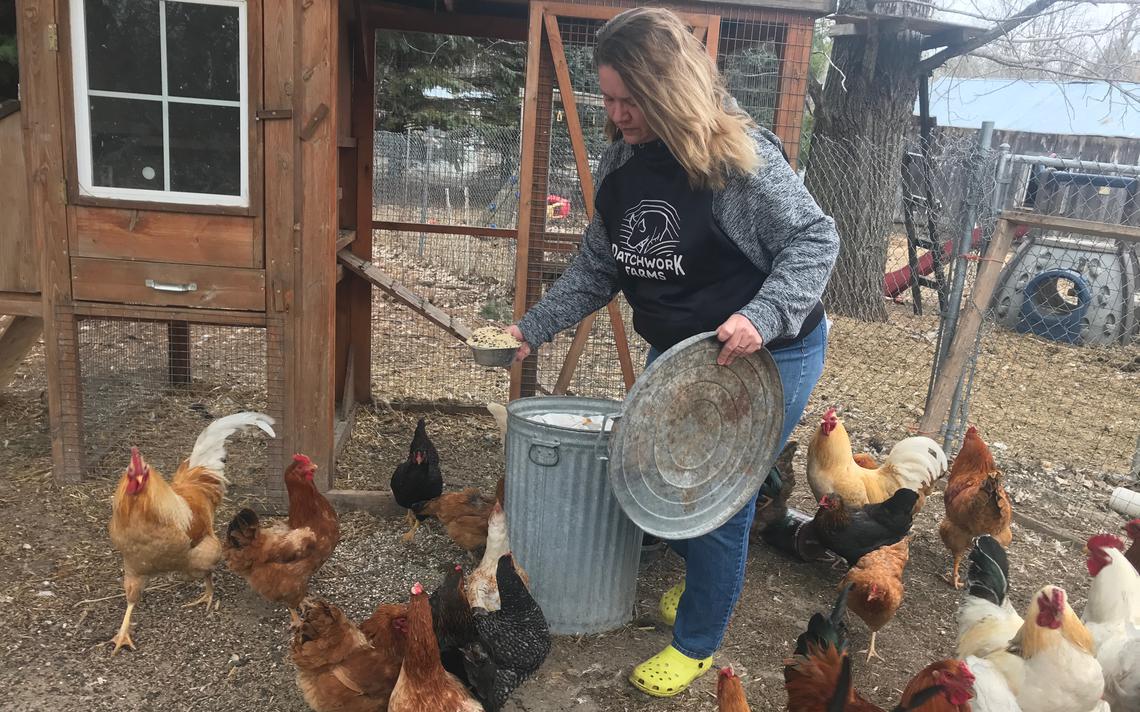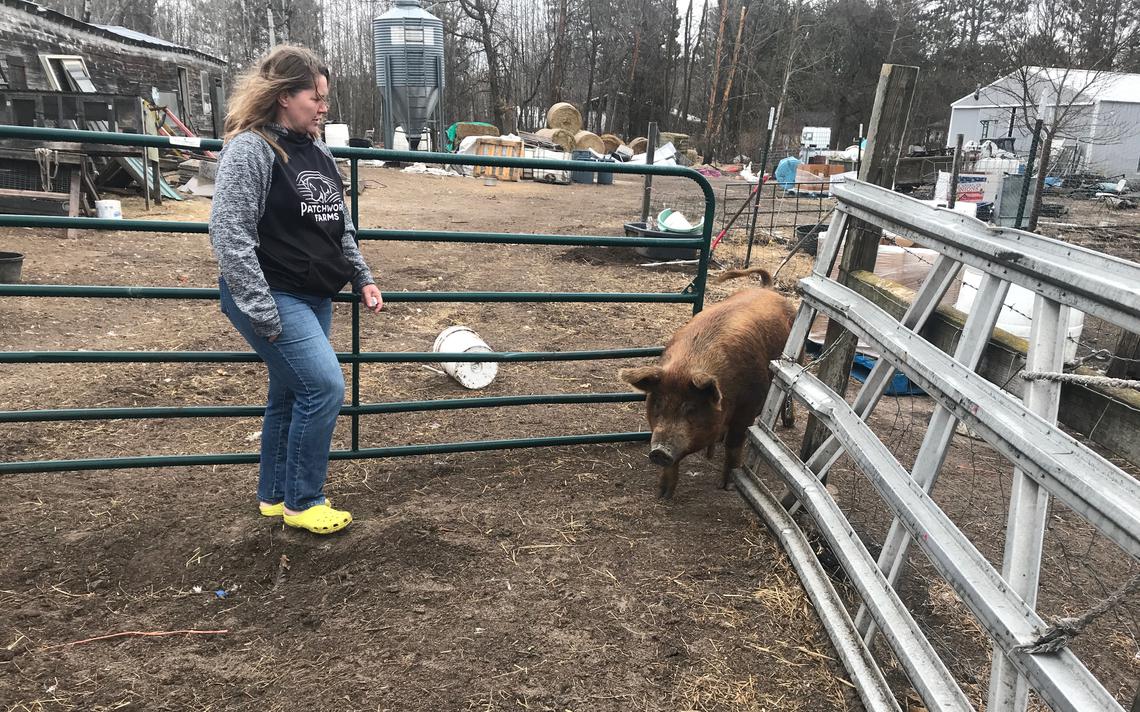|
By Sheila McCoy of the Morrison County Record - March 16, 2024 This year, Sprout in Little Falls is celebrating 10 years of making a difference in the community and surrounding areas. It is an achievement Co-Founder and Executive Director Arlene Jones is proud of, but one she stresses couldn’t have happened had it not been for the communal support and people she’s worked with over the years. Sprout was founded by a group of women in 2014 who saw the need for a food hub in Central Minnesota. Besides Jones, those women include Janelle Riley, Jessie Borkenhagen, Sharon Wettland, Colette Pohlkamp, Colleen Landkamer, BJ Allen, Stacey Stockdill and the Deb Angulski family. Arlene Jones, co-founder and executive director of Sprout in Little Falls, encourages people to find ways to support their local farmers. Jones said the women were already friends and used their individual skills to make it happen. Wettland, she said, has been opening restaurants throughout her life and has been in the food service business. Allen was in the solar business, but had built her own non-profit organization. Borkenhagen, whose last name is now Bavelli, had been working with Jones on her farm for about five years and had the agricultural production experience and knowledge. She had also been managing the community supported agriculture (CSA) program with Jones on the farm. Stockdill has a PhD in statistics and Pohlkamp was a food service director for the Brainerd School District, which is the largest school district in Central Minnesota, Jones said. “They are the co-founders. They sat at boardroom tables with me for hours and hours and hours, going over data. ‘If we did this, how would we do it? If we did this, how would we do that?’” Jones said. “We started putting numbers on paper and that’s where Janelle came in. Allen did a feasibility study and Sharon gave us all the data on broadline distributors. Colette was the buyer group for seven districts in Central Minnesota, so she knew exactly what every school bought, exactly what the price point was and exactly what was on their menus, because she created them” Jones said Cheryal Hills, the executive director of Region Five Development Commission, joined their adventure. “She had the networks and relationships that were critical, because none of us had them. We were all working in our own little pods and we needed that economic development,” she said. Jones said Hills contacted Carol Anderson, executive director at Morrison County Community Development. A variety of businesses, organizations and entities supported the idea of a food hub and with funding, Sprout soon became a reality. Sprout is located in the former Crestliner building. Back in 2012 and 2013, the building was under-utilized after the boat company closed its plant in Little Falls. “Carol worked really hard as a newly founded non-profit to get us a very minimal long-term lease that allowed us to continue to grow the concept without having to be overwhelmed and underwater by a lease you couldn’t afford when you’re a startup,” Jones said. At the time Sprout moved into the former Crestliner building, two commercial kitchens were installed. At that time, Jones said, there were no shared use licensed kitchens in the area. The significance of a shared use licensed kitchen, she said, is that it allows people to use the kitchen to prepare food products to sell wholesale and be in compliance with Minnesota state laws that govern that. Jones said while people can still make products to sell in their home under a Minnesota cottage food license, those products can only be sold directly to the consumer. Having commercial kitchens also enabled Sprout to host cooking classes, nutritional education, events and more. The name itself — Sprout — Jones said came to her when she was taking a photo of a frog in her greenhouse. Next to the frog was a little sprout growing. While pondering on the name “Sprout,” Jones said it also dawned on her what each letter in the name stands for — Sustainably Produced Regionally On Ur Turf. It was also that same little sprout growing in her greenhouse that inspired the logo for the organization — a sprout, she said. Looking back to the beginning and the need for a organized food hub in the area, Jones said back then growers were working together to fill larger orders. There were also other people in the community who were working on getting buyers to come to table, as “local food” became increasingly popular. Part of that was also understanding that the agricultural community in Central Minnesota is an economic engine, Jones said. “While we have all of the lakes north of us, we have some of the most viable fields here in Morrison and Todd counties,” she said. The mindset back in the years leading up to the establishment of Sprout, Jones said was on figuring out a way to continue to grow food to feed the people in the local areas. That concept also included how to encourage local institutions that serve people, such as hospitals, restaurants and school districts, purchase the food locally. “That consumer attitude of living more locally was kind of the mindset back then and understanding that in working with numerous growers throughout the region, the growers benefit from the work we do,” she said. Over the years, Sprout has worked with more than 200 growers with an average of 60 to 70 growers per year. As the producers then spend much of their revenue locally, it benefits the economy in the area. “The money is spent locally in our communities, whether it’s buying gas, groceries, whatever it is, so supporting agriculture turns out to be one of the ways that we can support our entire local community and that was really why we built the food hub,” Jones said. By supporting the local agricultural economy through the work those at Sprout do, the organization is also not in competition with other local food entities, such as the Purple Carrot or the Farmers’ Market. “We are partners in this work that we support. We all have the same mission and that is keeping our land in agricultural production and helping small family farmers in providing the residents and citizens access to locally grown, nutritious, healthy food, which benefits our health economy, as well,” she said. Jones encourages the communities, cities, townships and regions to support the work of local foods and food hubs, whether it is signing up for CSAs, purchasing for institutions or buying from a grower at the local Farmer’s Market. The importance of local agriculture became even more evident during the pandemic, Jones said. “If we learned one lesson from the pandemic, we learned about supply chain disruptions. We learned that if we don’t spend our money locally in our communities and we don’t work hard to find those opportunities, we’re going to lose the opportunities to do that,” she said. Other ways to support local food hubs, Jones said, is to attend their programming, sign up to volunteer and learn what they do.
Living on a bio-diverse farm, Jones has orchards of plums, apples and currants. She also has 4,500 square feet of high tunnels and about two acres of real crop production. In the past, she had 612 acres of real crop production, but has since downsized significantly as it is difficult to find workers. Nevertheless, she knows first hand the variety of vegetables can be grown. Having been involved with CSAs for nearly 20 years, Jones said during research she found that only about 3% of crops that can be grown in Central Minnesota are available in grocery stores. The seed availability in Central Minnesota, on the other hand, is 97%. “That means you are not going to find a purple carrot in the grocery store, heirloom tomatoes or different varieties of cucumber,” she said. “The average consumer doesn’t have access to that, but we can grow it here in Central Minnesota.” In addition, Jones said, food that is purchased locally is going to have a longer shelf-life as it was harvested within days of it being sold in comparison to having been held for two weeks or so before being delivered to the store. For more information, visit www.sproutmn.com. Recently starting the committee “Cooking for Our Neighbors,” several coordinators and volunteers gathered at Sprout in Little Falls, Tuesday, Jan. 9, to prepare 150 meals. The meals were then frozen to be distributed to people in the community, who can use them. The distribution is made through the Morrison County Drop In Center, located at 120 East Broadway, Little Falls. Oasis Central Minnesota board chair and Purple Carrot Market owner Judith Hecht said since Oasis’ Share a Meal ended in 2020 as a result of the pandemic, many people have asked when the outreach will return. Share a Meal was a weekly event where a free meal was served at First Lutheran Church in Little Falls. “It’s not coming back, but this is taking its place,” she said. Several coordinators of Cooking for Our Neighbors and members of sponsoring organizations gathered at Sprout to chop meat and vegetables, Tuesday, Jan. 9. Pictured are (from left): Mari Ludwig (Oasis Central Minnesota), Darlene Brand (Purple Carrot Market board member), Cynthia Johnson ( Sprout employee and Purple Carrot Market board member) and Judith Hecht (Oasis Central Minnesota board chair and Purple Carrot Market owner). Cynthia Johnson, food systems program and outreach coordinator at Sprout, said “Cooking for Our Neighbors” was also the name of a similar event last year. While the event was successful and was intended to be ongoing, it was very difficult to find the time as the people involved were busy with other commitments. “So Oasis was kind enough to really move this forward and pick it up and just get it on the calendar,” she said. With approval of taking over the name, Hecht said the committee “Cooking for Our Neighbors” was formed and is a collaboration between several local organizations and entities — Sprout, Purple Carrot Market, Oasis Central Minnesota and the University of Minnesota Extension in Morrison County. The meal the coordinators and volunteers prepared Jan. 9, Johnson said, was a dirty rice skillet with cheddar bratwursts that were plated in burrito bowls. Johnson said the Morrison County Drop In Center provides a variety of services. In terms of the food made by “Cooking for Our Neighbors,” the frozen meals will be available on a first come first serve basis. As such, there is no guarantee there will always be meals available. “People can pick it up and heat the meal at home or at the Drop In Center. That option works great for people who may be homeless or in transition,” she said. Many hands make light work preparing 150 meals for Cooking for Our Neighbors. Pictured are volunteers (from left): Julie Richgels, Bill Hecht, Lois Merchant- Stumpf and Tim Ludwig, all of Little Falls. Another detail the Cooking for Our Neighbors Committee has established is that the meals will not be tracked in terms of needing names of the people who receives them. The reason for that, Johnson said, is that they feel people may sometimes be put off asking for a meal if such is required. “We just want people to be able to get a meal if they need one without any strings attached,” she said. Judith Hecht transferring cooked rice from the pot to a plastic container. The meals that were prepared Jan. 9 were sponsored by the different organizations and entities in the collaboration. Hecht said the Little Falls Exchange Club also gave Oasis a generous donation to purchase a freezer and packing equipment for Cooking for Our Neighbors. Johnson said that overtime the number of meals that are made may increase. The goal as of now is to see if there are enough people interested to form two groups per month to make meals. As such, the Cooking for Our Neighbors Committee is encouraging individual people, as well as businesses to form teams to volunteer to prepare meals. Cynthia Johnson holding a bowl of chopped onion. With enough volunteers, the work can also be divided into two or three shifts with groups of eight to 10 people. After all, many hands make light work.
As the outreach requires funding to keep it going, the Committee encourages people and businesses to donate to the cause. Every little bit helps. “We encourage local agencies and businesses to sponsor a meal or come help make a meal or both,” said Samantha Barron, SNAP education health and wellness educator with the University of Minnesota Extension — Morrison County. Johnson said as the outreach is in its early stages, a pantry has not been built up. As a result, there are a lot of initial expenses, such as purchasing spices, bags of rice, packaging and more. Looking to the location of the Morrison County Drop In Center in downtown Little Falls, Hecht said it may be easier for people to access the food. One challenge some people had when the Share A Meal program was ongoing was to find transportation to First Lutheran Church, as it is located nearly two miles from the central location of Bank Square in downtown Little Falls. To donate, make a check out to “Oasis Central Minnesota” with “Cooking for Our Neighbors” written in the memo. The check can then be mailed to Oasis Central Minnesota, PO Box 542, Little Falls, MN 56345. To volunteer, contact Barron at [email protected] or (320) 632-0163. By Zach Hacker of the Morrison County Record - Nov 25, 2022 Sprout Food Hub Founder Arlene Jones speaks to the Little Falls City Council, Monday. A food collaborative consisting of Sprout, Purple Carrot Market and Little Falls Farmer's Market recently learned it received a $233,803 USDA grant. Staff photo by Zach Hacker The Little Falls Local Food Collaborative recently got a major boost in advancing its mission.
The group — which was formed within the past year — recently learned it received a $233,803 grant from the USDA National Institute of Food and Agriculture (NIFA). Consisting of representatives from Sprout Food Hub, Purple Carrot Market and the Little Falls Farmer’s Market, the collaborative aims to expand access to local, affordable food sources, provide nutrition and culinary education, promote healthy living throughout the community, and more. In speaking to the Little Falls City Council, Monday, Sprout Founder Arlene Jones said the local food, local places action plan within the OurTown 56345, community-driven visioning was instrumental in helping the collaborative receive the grant. “I need to tell you that this was an extremely competitive grant,” Jones said. “Had we not done the work of engaging our community at large in local foods, local places, and listing those community-driven goals in that action plan in the OurTown visioning process, we would not have achieved and secured this grant.” The total grant amount will be spread over two years. It officially began Nov. 1, and it will last through Oct. 31, 2024. The funding will go toward several aspects of advancing the collaborative’s overall mission. From a budgetary standpoint, the grant will help fund a project manager for the Purple Carrot Market — a local food cooperative — for two years, and another for the Little Falls Farmer’s Market for one year. The project manager with the Purple Carrot Market will work with the Board of Directors to advance its priority of opening the market, which will be located in the Victor Mall building on East Broadway in downtown Little Falls. “They’ve got a dedicated Board,” Jones said. “They’ve got a dedicated group of sub-groups that are working on this. This will allow the people that are working in unpaid positions to actually hire a project manager under the guidance of the Board of Directors of the Purple Carrot Market to move that project forward for two years.” In terms of the Little Falls Farmer’s Market, the project manager will help advance some of its initiatives, such as establishing a site for a permanent structure to house the market. That will allow the market to continue its work of allowing community members to participate in the commerce of local foods and local artisan projects without worrying about the weather, according to Jones. The grant will also fund equipment for both the Purple Carrot and the Farmer’s Market. That will include refrigeration and freezer space for vendors. It will also provide opportunities for Sprout to continue in its endeavors involving nutrition and culinary education. “Without continuing to educate our community, we will not continue to advance the economic opportunities of local foods,” Jones said. She said the collaborative has already received letters of commitment for staff time over the course of two years from Community Development of Morrison County, Visit Little Falls, the Little Falls Area Chamber of Commerce, Region V, the Purple Carrot Market and the Little Falls Farmer’s Market. In giving the presentation to the Council, Jones asked for its continued support of the collaborative and its mission. She thanked council members and city staff for already being supportive, without which they would not have received the grant. “To all of you that participated, to all of you that raised up your voices, to all of you that said, ‘This is what we need to do in order to have a vibrant community that’s healthy and that we have access to local foods and that we’re advancing our goals,’ I want to thank you,” Jones said. “I think it’s a great achievement.” Susy Prosapio, president of the Purple Carrot Market Board of Directors and a member of the collaborative, said the cooperative is up to 705 owners. That is evidence, she said, that the community sees the vision and the need to bring local food in a retail setting to the community. She said the timing of the grant funding is perfect for their organization. “The Purple Carrot is now working very hard at getting our store open,” Prosapio said. “There are many committees working. The project manager will help us coordinate all of that work so that it’s not volunteers, that when one person gets busy, the project doesn’t move forward. The project manager landing right now is so incredibly important.” As they continue to work on opening the retail location, she said they will be working to get additional grant funding for the entire project. The fact the equipment will be covered by the NIFA grant will allow them to focus on working toward dollars for construction. Ultimately, it will help keep the project as a whole affordable, she said. Little Falls Farmer’s Market Director Birdie Pederson said the market has been a part of the community since the 1880s. “We’ve gone through all of those years through the wind and through the snow and things like this,” Pederson said. “That’s what we are also working toward — a permanent structure.” She said the refrigeration and freezer space will also be vital. A meat vendor typically comes to the market with what looks like a fish house. That contains her freezer, and she has to bring a generator in order to meet regulations to sell frozen food at the Farmer’s Market. “This would certainly benefit all of that,” Pederson said. “We are delighted,” she added. Jones also asked the Council to support the collaborative’s desire to form a Food Policy Council for Little Falls and Morrison County. That will have to be granted by resolution from both the City Council and the Morrison County Board of Commissioners. She said forming a Food Policy Council will allow them to continue to address and provide goals that “improve access to nutritious, affordable and culturally suitable foods; promote healthy eating; encourage nutrition education, consumer-wise, through our assets that we have here in Little Falls and in our schools; promoting and buying and utilizing local food,; promoting local food processing; and promoting our farmer’s market.” No local unit of government — neither the city or county — would incur any financial liability if such a council is formed. However, she said “any reputable food policy council” does have a representative from the local government to act as a liaison between the two entities. “We know that all food policy councils that are successful include a vast diversity of representation from local units of government, school districts, public health, nonprofits that are invested in food systems and higher education,” Jones said. She said Sprout is willing to go after any additional funding that will help support the Food Policy Council. According to Jones, Little Falls is home to the only rural, brick and mortar food hub in the state of Minnesota. The only other physical food hub she is aware of is in Falcon Heights, a suburb of the Twin Cities. She added that members of Sprout have recently met with people in Duluth and Fargo who are wanting to start a food hub of their own. They are using Sprout and Little Falls as a model for how it can be done outside of a major metro area. “I’m incredibly proud of the work that we’ve done,” Jones said. “We’ve come a long way, but we’ve got a long way to go.” She said there are still a lot of issues to address and voices that need to come to the table to work on issues such as the increased senior population, the veteran population and “all others that need adequate food.” As food prices continue to rise, she said more and more people will suffer. “We have the ability to do something,” she said. “I’m asking you to consider being part of the work that we’re doing and, as a city, to lift us up.”  Photo by Savannah Howe Photo by Savannah Howe By Savannah Howe, Minnesota Women's Press Founded in 2012 by a league of women invested in collective economic and community development, Sprout connects growers and eaters. After the operation grew too big for one farm, a facility was built with commercial-level amenities to support family-level farmers. More than 18 million acres of Minnesota land are used for field crop planting (corn, soybeans, wheat, hay, potatoes, sweet corn, canola, sunflower, peas, oats, barley, beans, rye, and sugarbeets). Simultaneously, poverty continues to plague one in nine Minnesota children and one in 11 adults, according to the Minnesota Department of Health. Meanwhile, across the country, 11 million acres of farmland have been lost from 2001 to 2016 to residential and urban developments. In Minnesota alone, the family farm is disappearing as agricultural operations shift from household endeavors to machines that have greater consolidated yield. In a time where convenience champions our diets and efficiency dominates our agricultural space, some Minnesota growers are slowing down. They have no interest in adding zeros to the number of acres they farm. Their goal is to put fresh, locally sourced ingredients into neighboring homes. This is where organizations such as Sprout, a nonprofit farm-to-table food hub in Little Falls, play a role. Sprout seeks to strengthen the health and vitality of the region — the counties of Crow Wing, Morrison, Cass, Todd, and Wadena — with farmers who offer their crop not by the acre, but by the plateful. Founded in 2012 by a league of women invested in collective economic and community development, Sprout connects growers and eaters. After the operation grew too big for one farm, a facility was built with commercial-level amenities to support family-level farmers: walk-in coolers, freezers, and more. A community kitchen enables caregivers to gather together for meal preparation and support. Empowering Growers and Families One of Sprout’s missions is to ensure that small family farmers have equitable access to the local food economy by paying growers fairly and providing access to markets. Many of the local farmers supported by Sprout are traditionally underrepresented, with barriers in the agricultural market: Latinx, tribal, female, and Amish growers. Language barriers or immigration status may create obstacles in a farming community that has traditionally been white, male, and supported over generations. Yesenia Lopez faced those challenges when she began farming organic produce on 1.5 acres in Long Prairie with her sister Alicia. The sisters emigrated from Zacatecas, Mexico, during high school. They grew up on a small family farm with goats, where her father grew corn and beans. Lopez believes it was maternal instinct that led her to start farming: wanting to take charge of the food that was fueling her two children. Her son, Gabriel, had low iron levels. Her daughter, Emily, was struggling with anxiety, which Lopez suspected was impacted by the food she was eating. “Your body will reflect what you eat,” Lopez says. “I have seen it.” She says her daughter is more relaxed since they started producing more of their own food. Lopez remembers struggles faced by her father in dry Zacatecas. Without a water irrigation system, he was always left wondering if he would have a good or bad year, depending on rainfall. Growing in Minnesota, she says, has been much easier, and not just for the environmental conditions. “We have had a lot of help here,” she says. “We have been blessed with many resources.” Last year was the first year of growing, and Lopez says she feels fortunate to have connected with Sprout, which became their main source of income — selling bell peppers, jalepeños and zucchini. Lopez and her sister are farming together. Their produce is used in a family restaurant and grocery store. This year, the sisters plan to approach local schools, hospitals, and clinics about contracts. Lopez credits resources like Sprout and the Latino Economic Development Center (LEDC) for helping them get in the ground. LEDC helped them rent equipment and land. “When you are starting out, it can be challenging to get yourself out there,” she says. “Especially when you [are] a woman. I think that is not what [many people] picture a farmer to be.” She feels supported by the community. “They want us to succeed,” Lopez says. “Sometimes you may think that you cannot do it, maybe because you are not extraordinary, maybe because you just moved here a couple years ago, or because there are not enough resources for you to do it.” Bolstering the Food Economy Sprout hopes to strengthen the roots of the local food network in the upcoming growing season in order to help busy people make healthy, wholesome meals with neighborhood ingredients. The organization is launching an online store as a new market opportunity for growers, and a more accessible avenue to fresh produce for buyers, to complement its monthly food subscription box. Sprout and similar organizations are also seeking to tear down barriers to land and resource access and uplift the voices of underrepresented farmers across the state. Minnesota’s farming demographic is aging. The need for a thriving food culture is growing. Sprout is working to make sure connections between agriculture, culture, and art inspire more generations of family farming communities. Lopez’s advice for emerging farmers is to put fear aside and find, or build with others, the resources around you. Sprout works with numerous restaurants, food cooperatives, hospitals, long-term care facilities and manages a direct-to-consumer Community Supported Agriculture Program. LITTLE FALLS — Alongside Brainerd School District and Crosby School District Food Service Directors, Sprout MN launched a Farm to School Recipe Manual, which has been distributed to all school districts in Cass, Crow Wing, Todd, Morrison and Wadena counties. Through this U.S. Department of Agriculture Farm to School grant funded program, Sprout MN led this collaboration with area school districts to develop, test and implement brand new recipes that feature often underutilized produce, including beets, carrots, rutabaga and squash, the news release said. A core team consisting of food service directors, head cooks and food service staff created, developed, critiqued and adjusted the recipes. Students participated in six sensory exploration tasting events. The core team then completed Train the Trainer sessions of more than 24 additional food service staff. Sprout MN is focused on strengthening the local food system in central Minnesota by connecting growers, eaters, creatives and economic developers to increase healthy food access, encourage entrepreneurship and cultivate creativity. Sprout’s story is deeply rooted in supporting farm to school initiatives and its pioneering spirit has helped school districts and growers around the state create farm to school networks of their own. Sprout specializes in working with small family farms to aggregate locally produced fruits, vegetables and shelf-stable items that are 100% produced in central Minnesota. Sprout works with numerous restaurants, food cooperatives, hospitals, long-term care facilities and manages a direct-to-consumer Community Supported Agriculture Program. The farm to school network creates immeasurable positive impact on both producers and school districts nationwide. For Sprout and central Minnesota districts, the initiative has been instrumental in education of students and staff about the origins of the produce on their plates. Sprout seeks opportunities to support small family farms in central Minnesota through the longstanding relationships with food service directors and to advance our efforts on innovative ways to continue to introduce locally grown, nutritious foods onto the plates of school-aged children. The Farm to School Manual, with 30 recipes highlighting Minnesota Grown products, is publicly available and can be accessed at: bit.ly/3r7OPsM
To learn more, visit www.SproutMN.com and follow the Sprout MN on Facebook. By: Zach Hacker, Morrison County Record
“Together, all three of our organizations have formed an informal collaborative to try to meet the needs and opportunities of the citizens here in Little Falls and all of the surrounding communities,” Prosapio said. “We’re hoping to work together to help strengthen the local economies as we all are trying to recover from (the pandemic).”
“We have the ability — for consumers — the ability to access healthy foods,” Prosapio said. “Not everybody can hop in a truck and go out to a farm and pick up foods from there. Some folks have difficulty going over to a farmers market. We need greater access.” That access, she said, is not only on the consumer side. Producers also need greater access to markets and the ability to get their products to consumers. She said the collaborative also identified a need and an opportunity to improve the health of community residents. With that, there is also a chance to expand the local economy and utilize foods as an economic engine for the Little Falls area. “Supporting our local agricultural community is the easy part, but it also increases tourism,” Prosapio said. “People actually drive places to access healthy, local foods.” She added that the phenomenon of people wanting to know where their food is coming from is being felt throughout the state and nation as a whole. The group believes a strong local food system in Little Falls would help make it a more desirable community when people are looking to relocate. Her organization, Purple Carrot, is a local food cooperative that started in 2015. She said it currently has 637 owners, 73% of whom live within the Little Falls ZIP code and 90% of whom are in Morrison County. Purple Carrot owns and manages the Victor Mall on East Broadway. Eventually that will be the site of a full-service grocery store in downtown Little Falls. “The Purple Carrot is committed to sourcing as much food as we can from local producers, so we now would have a convenient downtown location for people to access food,” Prosapio said. “Interestingly enough, that area is considered a food desert by the definition of the USDA. We would be bringing a full-service grocery store into a food desert.” She added the location would also help alleviate transportation barriers to accessing local, healthy food. The market will also accept SNAP and EBT to ensure low-income families will be able to access its wares. “I want to tell you, on behalf of the Purple Carrot, we feel really fortunate to have a really vibrant local farmer’s market and Sprout, a local food hub,” Prosapio said. “It makes the work of a local food cooperative much easier, and it really goes to our mission.” Pederson said the Little Falls Farmer’s Market dates back to the 1880s, though it looks a lot different now. In its early days, there were live pigs, chickens and more. At one time, she said the city was known as the “Largest Little Pig Market in the World.” The farmer’s market operates at the Boys and Girls Club on West Broadway from May through October, each Wednesday and Saturday. She said they’ve had to put up with some inclement weather over the years, but in 2021, the market didn’t miss a day. Pederson said it is the only established farmer’s market operating in Morrison County. “The last couple of years, we have definitely increased our vendors and shoppers,” Pederson said. It averages about 50 vendors throughout the season. On Saturdays during the peak season — July and August — Pederson said the farmer’s market has become a gathering place for community members “to shop, to visit, to share stories, to gain information from the farmers and growers.” In 2021, the market began accepting SNAP and EBT. It did about $1,000 in sales for people using those payment methods, which she said has increased accessibility. It also implemented the Power of Produce, a youth program that allows children to get a $2 token each week to buy their choice of fresh fruit, vegetables or a plant that produces healthy foods. In its first year, there were 187 kids registered in the program, which amounted to 501 visits. “Doing your math, that’s $1,000 into our community to our kids that we gave fresh produce to,” Pederson said. Pederson said the Little Falls Farmer’s Market is proud to bring local food to customers, promote health within local residents and support producers and the local economy. The last of the organizations to present, Sprout is a 501(c)3 food hub which specializes in working with family farms in procuring locally grown commodities and distributing them to consumers, hospitals, restaurants and other large institutions, Jones said. She said Sprout recently finished a USDA grant with two schools in central Minnesota to produce a manual for 30 recipes that have been scaled up for large-scale production. The goal, she said, is to continue to increase use of local foods and provide curriculum for students that demonstrates the value of agricultural economies in central Minnesota.
One of the ways Sprout has worked to provide educational opportunities is through its two fully-licensed kitchens at the Sprout facility, which is located in the old Crestliner building. Jones said providing nutrition education builds the intellectual capacity for the people the organization hopes to serve. “You cannot just hand somebody who’s lived off of processed foods a rutabaga or a turnip and ask them to produce something that tastes good that they’re going to want to eat,” she said. “For us, nutrition education is a very high priority.” Another key priority is food access, particularly for low-income individuals who are experiencing food insecurity. Jones said Morrison County’s food insecurity rate is 9.7%. For her, personally, another target area is serving veterans and other service members. Since Sprout started in 2015, it has provided 1,200 weekly or bi-weekly household assistance boxes free of charge to residents in Region 5, with a focus on Little Falls and Morrison County. Of those, 175 have gone to veterans. Jones said 100% of the organization’s fundraising dollars go toward the free weekly boxes and household assistance. During the pandemic, Sprout repurposed its mobile food market to deliver those meals to homebound individuals. It’s something she said also benefits producers.
“As a small family farmer myself, I know how hard it is to grow our food and to get it to market, so I am particularly invested in keeping our agricultural land in ag production and supporting our agricultural economy,” Jones said. Ultimately, she said all three organizations involved in the collaborative are focused on increasing access to food, providing transportation and addressing transportation barriers, supporting and strengthening the local agricultural economy and using local foods as an economic driver in the area. She added that Sprout works with more than 150 small, family farms. Some of the organization’s statistics show the incomes of some of those families has increased 10% by having access to market channels and distribution through Sprout. “Little Falls is incredibly blessed to have an up-and-coming food cooperative, a long-standing farmer’s market — which is more than just access to food but is a community event — and a food hub,” Jones said. “There are only two operational food hubs in the state of Minnesota, and Little Falls houses one of them.” By: Sarah Kocher, St. Cloud Times MILACA — Though her greenhouse is full of them, a Milaca grower's pumpkins will not meet a toothy-smiled end on front porches this October. Instead, their rotund, mottled green shells will be split and Rachel Sannerud will scoop the seeds out of the yellow-orange flesh. These seeds are the end goal of a two-year grant project: growing pumpkins for their hulless seeds, called pepitas. Sannerud has committed to growing varieties of these pumpkins as a specialty crop for two years after receiving an approximately $11,000 Sustainable Agriculture Demonstration Grant from the Minnesota Department of Agriculture. "It's basically like a science experiment that you grow on farm," Sannerud said. 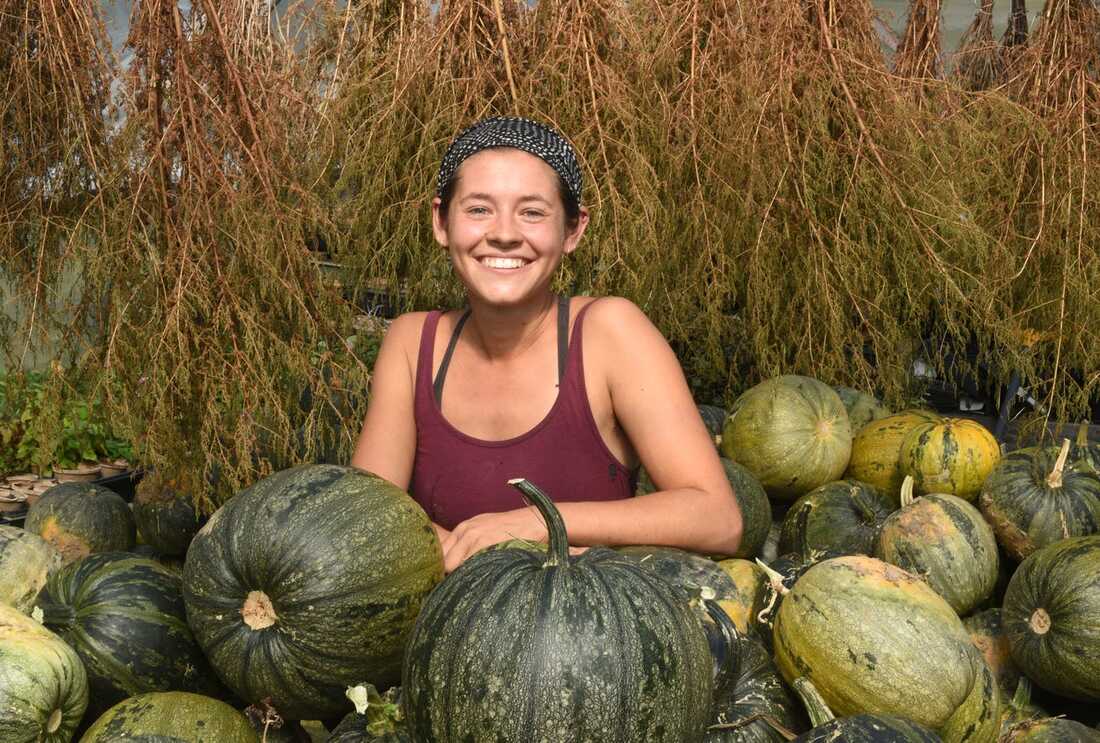 Rachel Sannerud, owner of Pluck Flower Farm, poses for a photo with her pumpkins Thursday, Sept. 24, 2020 in Milaca. Zach Dwyer, [email protected] Pepitas do not have the white, harder pith surrounding the pumpkin seed. They're slightly smaller, and come out of the pumpkin green. The seeds are a health food and can be marketed directly to consumers through farmers markets and also wholesale to places like restaurants and bakeries, Sannerud said. The grant allows her to explore growing hulless seed pumpkins without some of the financial risk. It's a learning experience, and the results of the experiment — what varieties work well, best practices for growing, pressure from disease and pests, good harvesting and processing methods — are shared with other farmers in a project report. Sannerud owns and runs Pluck Flower Farm, a small Milaca farm where bright blooms from zinnias and celosia were still growing Thursday near the pumpkin patch she's established for the experiment. 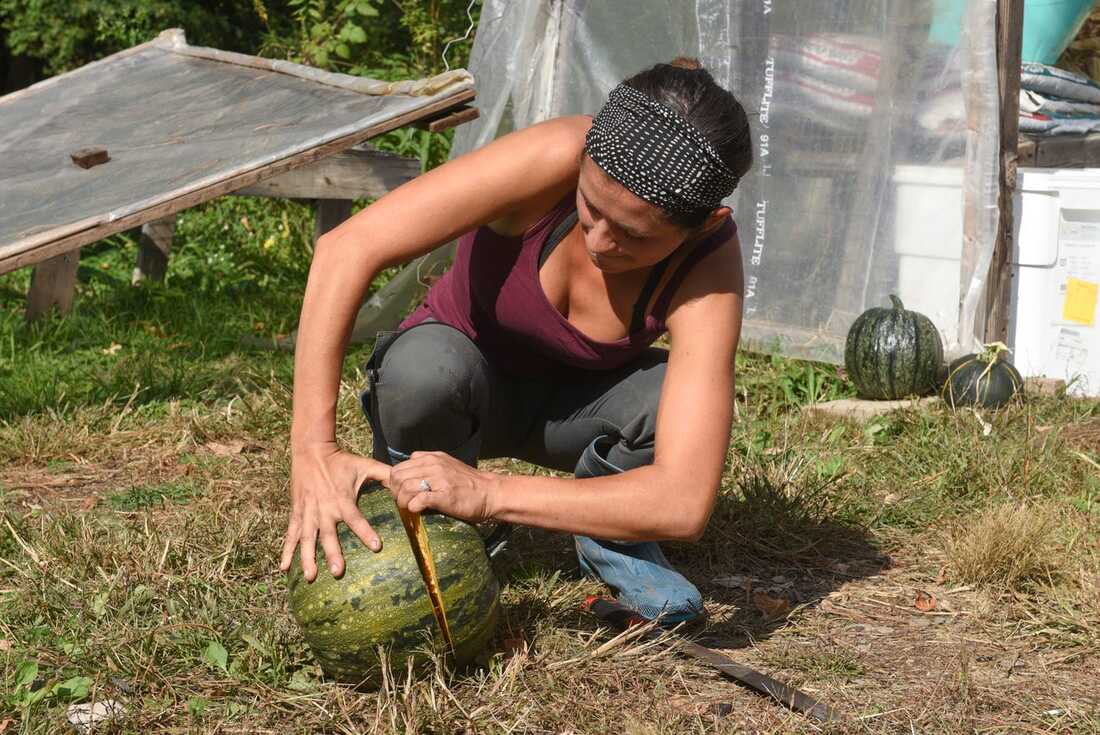 Rachel Sannerud, owner of Pluck Flower Farm, opens up a pumpkin after using a machete Thursday, Sept. 24, 2020 in Milaca. Zach Dwyer, [email protected] Hulless seed pumpkins have been grown in other countries and other parts of the U.S., Sannerud said, but haven't really been explored as a specialty crop in Minnesota. "For me and a lot of other small farmers, we want to know how it does here," Sannerud said. Sannerud bought the farm from three nearby brothers who live near the land she now cultivates. One passes along agricultural reading material to her — including a John Deere magazine with a feature article on hulless seed pumpkins. In the piece, Sannerud said, the seeds were being used for their oil. "What I took from it was that these are the same pumpkins that make the trendy seeds that go in people's granola," she said. "And I want to see if we can grow that." 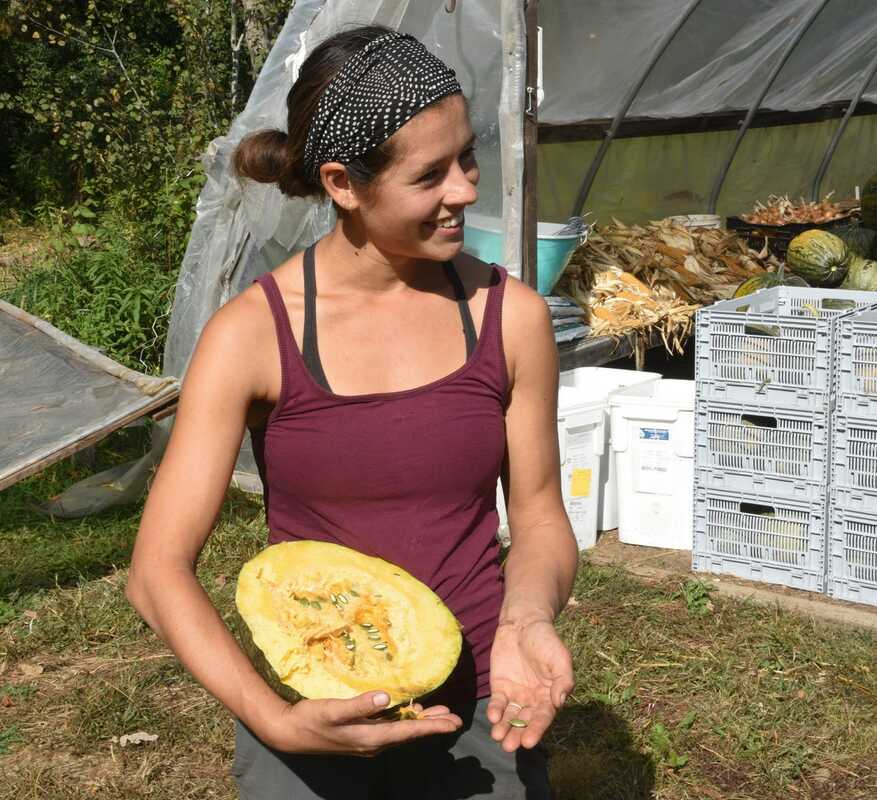 Rachel Sannerud, owner of Pluck Flower Farm, explains the difference in seeds for the new pumpkins she's growing Thursday, Sept. 24, 2020 in Milaca. Zach Dwyer, [email protected] The growing timeline also works well for her farm; the pumpkins need planting a little later than most of her flowers, and harvest time comes when her fresh flower work is winding down for the season, giving her more time to harvest and process them. They've been fun to grow, Sannerud said, but she doesn't have the information she needs yet to determine whether she'll plant these pumpkins past the two-year grant stint. To make that decision, she needs to discover some of the same things other farmers will want to know, too: How much time it takes to process the seeds, and what the yield is like. "If it all works out on paper, I'm absolutely interested," she said. She tested two growing conditions on her pumpkin plot. One half was not mulched, and the other was mulched with straw before the pumpkins were planted. She also grew three varieties of hulless seed pumpkins, which varied in the time to fruit maturation and size. One was a dual-purpose variety supposed to produce pepitas as well as flesh good for eating. 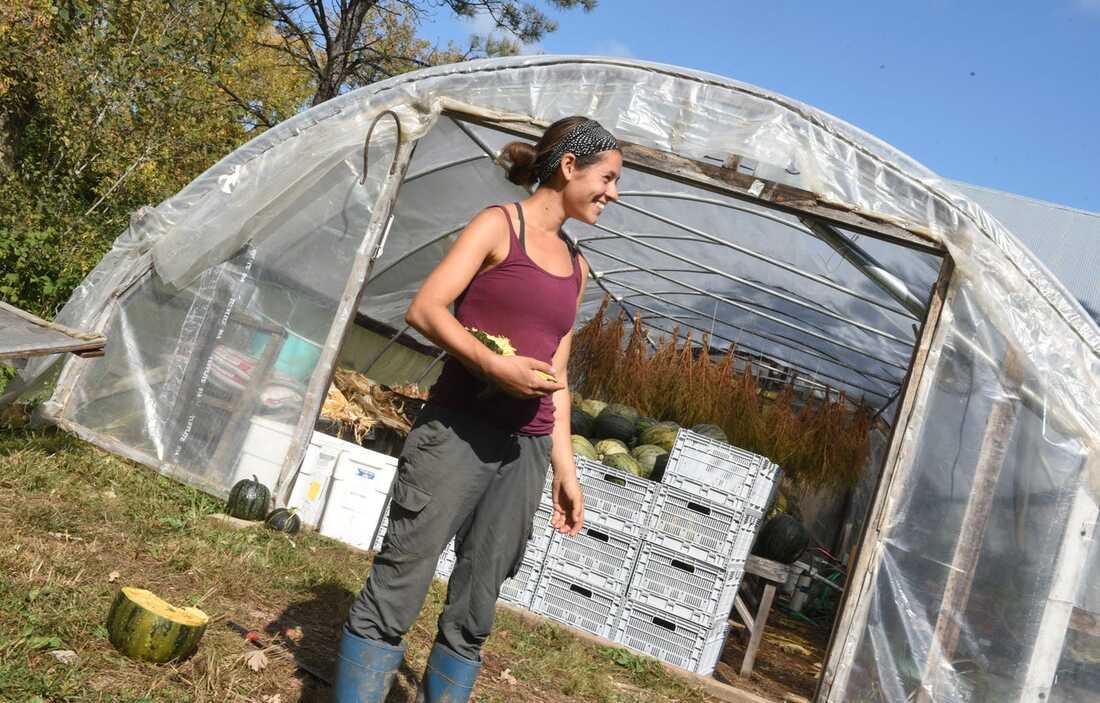 Rachel Sannerud, owner of Pluck Flower Farm, explains the difference in seeds for the new pumpkins she's growing Thursday, Sept. 24, 2020 in Milaca. Zach Dwyer, [email protected] Next year she'll repeat the growing process with modifications based on how this one went. For instance, her unmulched plot was supposed to be mechanically weeded, but the plants were too close together to fit the tractor she uses to weed. She had to weed the plot by hand. Once was enough. "I don't think I need to do that another year," she said, gesturing to the weeds in the unmulched plot. She may space them out more the second time around. Sannerud also plans to share her findings with other farmers on a field day next year. 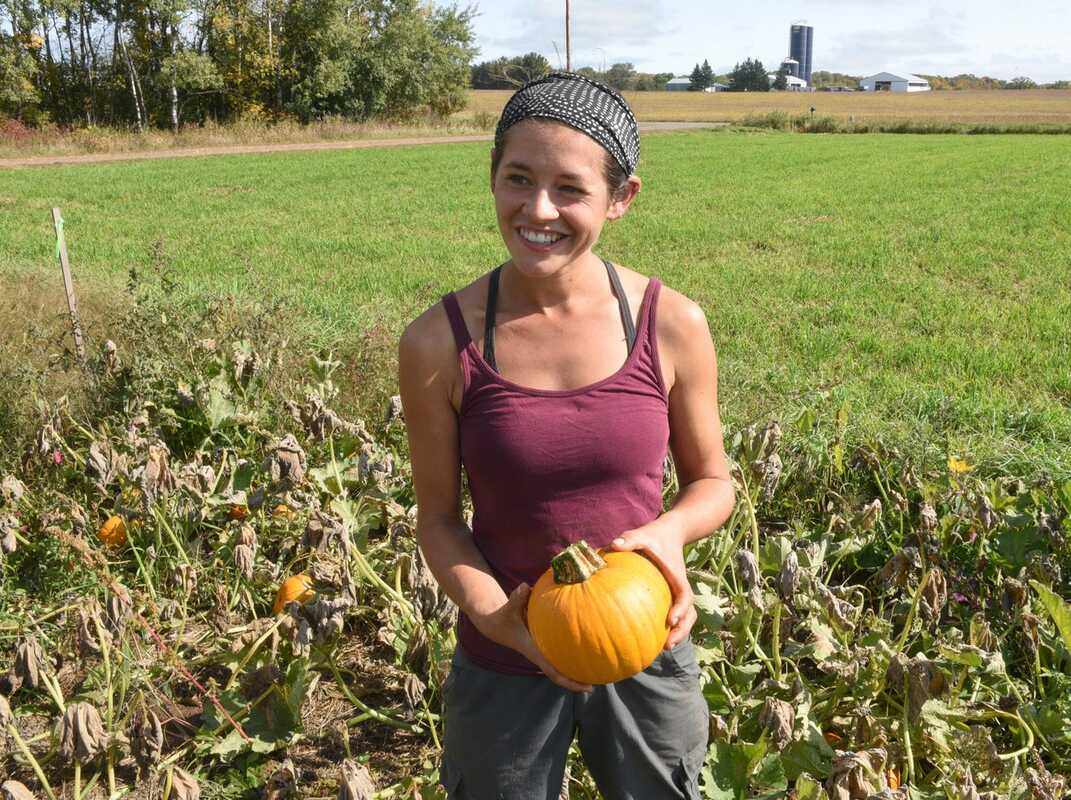 Rachel Sannerud, owner of Pluck Flower Farm, discusses the new pumpkins she's growing Thursday, Sept. 24, 2020 in Milaca. Zach Dwyer, [email protected] Sprout (a food hub in Little Falls connecting area farmers with both markets and direct consumers) is a collaborator on the project, Sannerud said, and she'll use their commercial kitchen to process the pepitas. After harvest, the pumpkins need to cure in her greenhouse. Then the pumpkins will move to Sprout, where she will cut them open, scoop out the seeds, wash and dehydrate them and package them. Grant projects are meant to explore sustainable agriculture practices and systems with the potential to increase profit, efficiency and personal satisfaction, a press release from the Minnesota Department of Agriculture said. For Sannerud, the grants are a chance for farmers to do something cool on their farms, and to help other farms become profitable — especially smaller farms, like hers. 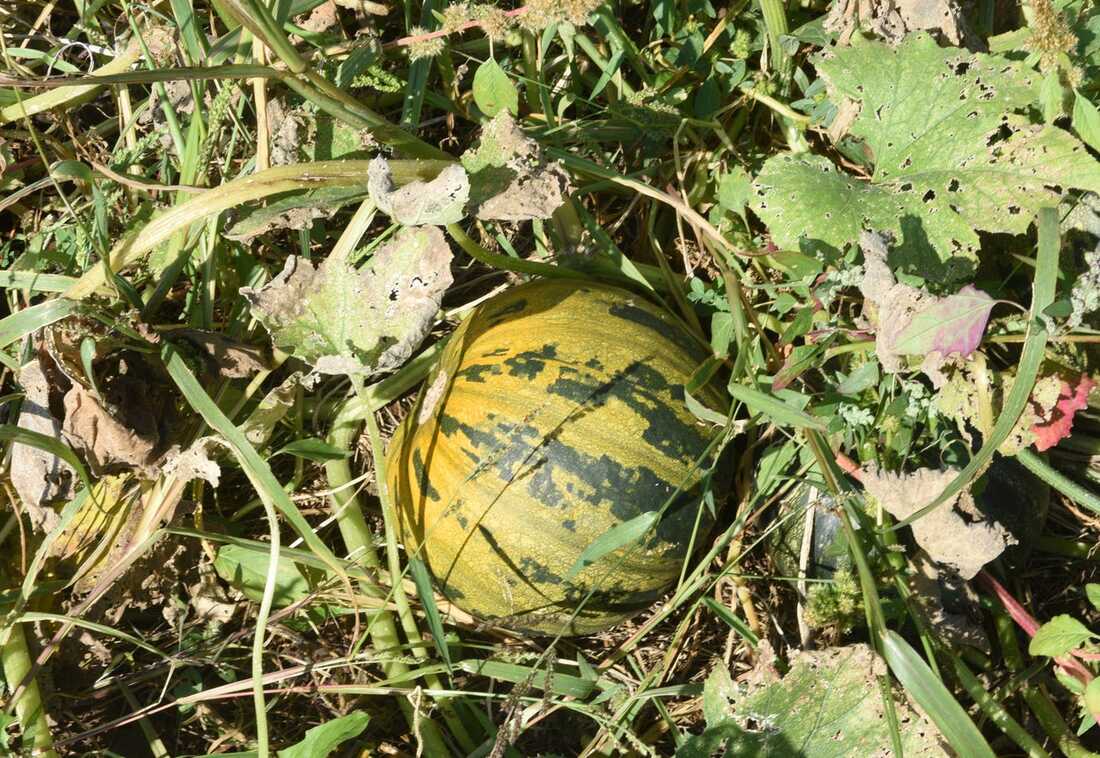 A pumpkin that has yet to be harvested sits in the field at Pluck Flower Farm Thursday, Sept. 24, 2020 in Milaca. Zach Dwyer, [email protected] Sannerud chooses what she does with her farm — what she grows and how she uses her land — very carefully, because it's largely her doing the work, she said. Any information that comes out of grants like these can make a really big difference, especially for younger and beginning farmers who already look for information like this on the internet. "That's the thing that excites me most is knowing that, if this goes well, it means it doesn't just go well for my farm," Sannerud said. "It means it probably goes well for a lot of other small farms like me, and that there's more small farms like me. And that means so much to me." Sannerud is one of eight farmers to receive a Sustainable Agriculture Demonstration Grant in 2020. Sarah Kocher is the business reporter for the St. Cloud Times. Reach her at 320-255-8799 or [email protected]. Follow her on Twitter @SarahAKocher.
Support local journalism. Subscribe to sctimes.com today. By Sheila McCoy, Staff Writer, Morrison County Record As people are finding different ways to support their local farmers during the novel coronavirus (COVID-19) crisis, one option to consider is signing up for community supported agriculture (CSA) shares, said Natalie Keane with Sprout in Little Falls. The CSA period runs from about mid-June for 16 weeks. People have the option to receive a box with a variety of vegetables either weekly or biweekly depending on their preference and family size. When herbs and farm-fresh eggs are available, those are added to the box. Community Supported Agriculture (CSA) shares allow subscribers to receive a box with a wide variety of fresh produce, such as tomatoes, cucumbers, broccoli, Romaine lettuce, red cabbage, green beans, green onions and zucchini, on a weekly or biweekly basis. The boxes are delivered to the subscribers. What kind of vegetables are included depends on what time in the season it is. “It’s almost like a gift that you get to open to see what’s inside,” Keane said. A recipe of a new, fun and sometimes unique meal is included in the box. It’s an opportunity for people who are getting a little tired of what they’re normally cooking. “It’s a great way to spice up the different types of things you may use or otherwise may pass by in the store,” Keane said. Most of the growers that provide the produce for the CSA program are located within a 50-mile radius of Little Falls. Some exceptions have been made when producers have something unique to offer, such as Doubting Thomas Farms in Moorhead, which produces flowers and Dancing the Land Farm in Clearwater, which uses high tunnels to grow some of their produce, Keane said. Sprout also works with a number of Amish farmers from the Browerville and Clarissa area. Like many of the other farmers, they focus on raising crops without using harmful chemicals to ensure that consumers are getting a fresh and natural product. Keane said many farmers, through the way they have treated their land, have cultivated a soil that is full of nutrients. 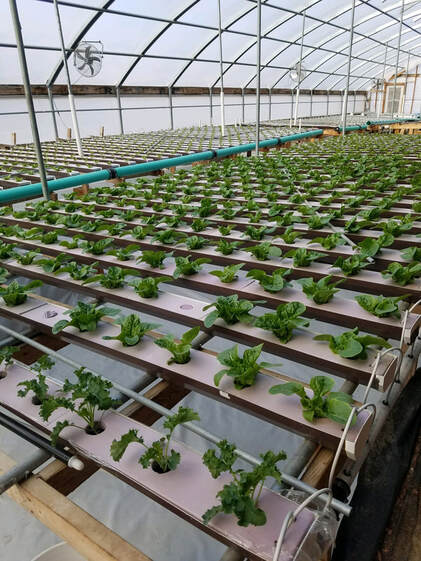 The produce provided through community supported agriculture shares come from different growers in Minnesota, including Barry’s Cherries, a hydroponic farm in Staples. The produce provided through community supported agriculture shares come from different growers in Minnesota, including Barry’s Cherries, a hydroponic farm in Staples. “Soil is just not dirt. It isn’t an inactive thing in the ground. It really is alive with many different properties and you really have to be a steward of the land in order to make sure you can keep that soil alive and healthy to grow fresh and healthy plants,” she said. Since the COVID-19 outbreak, Keane has seen an increase in people wanting to subscribe to CSA. “We are definitely finding more interest in the CSA, especially because it is a way to get your fresh produce without having to go into a store setting. People are considering their immune systems and it is pretty common knowledge that eating more fresh vegetables is a way to go about that,” she said. Another option Sprout has added are workplace CSAs. It is an opportunity for businesses to sign up as a way to offer their employees a little assistance. It can also boost employee morale and well-being. Keane said it can also be viewed as an employee wellness program as some employers offer their workers gym memberships to promote health. Through CSA, that can be done either by paying for or subsidizing the CSA. “During these unprecedented times, a fresh take to ensure employee wellness is needed more than ever. Sprout’s Workplace CSA brings local farm produce directly to members’ places of employment. This makes the Workplace CSA a convenient and attractive to connect employees with fresh, healthy produce while reducing the exposure that comes with traditional shopping trips,” Keane said. Keane said that both employers and insurance companies have become more aware of the benefits of engaging in proactive employee wellness program. “For every dollar spent on wellness programs, the average employee saves $3.27 in medical costs. In addition, sick leave, health plan costs, worker compensation and disability costs decrease by about 25% per year with these kinds of programs in place,” she said. Those who are interested in learning more about CSA shares, may visit www.sproutmn.com/csa. Written By: Chelsey M. Perkins, Brainerd Dispatch Producers believe what’s driving a spike in local farm business is a combination of people not wanting to shop in stores due to health concerns associated with the novel coronavirus, along with rising prices and limited availability of some meat and dairy products. NISSWA — Some farmer’s markets begin next week, and Gayle Stevens won’t have much pork to sell. The amount of money she might earn in a whole month during a typical early spring is coming in three to four times a week right now, flowing from both returning customers as well as new patrons of Patchwork Farms. The small heritage pig farm also sells eggs and beef, and Stevens made changes to allow for no-contact transactions on her front porch. She believes what’s driving a spike in her farm’s business is a combination of people not wanting to shop in stores due to health concerns associated with the novel coronavirus, along with rising prices and limited availability of some meat and dairy products. “I took in three pigs to the butcher yesterday (Wednesday). We start markets next week and I won’t even have the meat back yet,” Stevens said by phone Thursday, April 30. “I’ll have a limited supply of my pork products. Then he (the butcher) can’t get me back in until June. Three pigs’ worth of meat will probably be gone in the month of May.” Stevens said she can hardly keep up with the phone calls and isn’t able to help everyone who inquires. She recently received a phone call from a manager of multiple group homes in the area who is having trouble purchasing enough meat to feed 32 people. This is because of quantity limits placed on things like pork roasts and packs of chicken at grocery stores, she said. An impending pork deficit prompted Stevens to pivot Thursday — she placed rolling orders for about 800 Cornish cross chicks, which she’ll raise into broiler chickens. Ordering them all at once was another atypical move, but hatcheries are also overwhelmed with orders. Many aren’t able to ship new orders until late June or July. “We’ll do more chickens this year and some quail also. I thought, well, if I can’t supply enough pork and beef for a little bit just because of how busy my butcher is and I can’t get in until June. … I can get 100 (chicks) next week,” Stevens said. Laurence Fox of Fox Farm Pork in Browerville said he’s hearing similar stories from a number of small, local farmers who use his licensed butchering services, including Stevens. He’s booked solid for the next two months and mostly the rest of the year, when accounting for the 15 other small producers with whom he regularly works. “We’re busier than ever,” Fox said by phone Friday. “...Their freezers are all empty, and they’ll be running out of pigs by mid-summer to early fall. It’s just wiping us out. “ … I was going to expand last summer and I decided to wait until this summer. Now I wish I had the extra space to operate.” Sales increases in local foods as a result of the pandemic aren’t limited to meat and dairy. Arlene Jones of Sprout MN, a food hub based in Little Falls, said they’ve experienced a significant uptick in people purchasing community-supported agriculture shares, or boxes of produce and other local products delivered to consumers on a weekly or biweekly basis. This, in turn, is prompting produce farmers to ramp up their production. “A lot more people are looking at purchasing CSAs as they’re seeking alternative resources to going out in public and shopping,” Jones said. Jones said she’s seen other impacts, too, that seem promising for the local foods movement as people look inward to their own yards and communities as resources. “I think people who’ve always wanted to can and do food preparation are really going to find joy in that this year,” she said. “... I know people who have never gardened who are plowing up land to garden. It’s not like we’re doing victory gardens, but it’s pretty close.” Jones said Sprout also submitted a proposal for the U.S. Department of Agriculture’s Farmers to Families Food Box program as part of the Coronavirus Farm Assistance Program. The program will seek to distribute up to $3 billion of agricultural products to those in need, partnering with regional and local distributors. “We’ve gotten federal grants, but we’ve never actually contracted for distribution with the federal government as a method to support what they term small American family farmers,” Jones said. Pig problemsFox said he sees irony in high sales figures for what he described as premium-priced pork while the marketplace is flooded with thousands of cheap hogs. This is because larger-scale pig farmers are seeking to unload livestock directly to the public due to the closure or limited operation of meat processing operations across the Midwest. Those not sold are being euthanized in droves.
The hogs may be cheap, but openings with butchers are extremely difficult to come by, meaning many of those purchasing the hogs will likely have to butcher the animals themselves. Stevens said she’s beginning to hear from people wondering whether she would butcher a pig they’re considering purchasing from another farm at a bargain. “We can’t butcher for other people, and I can’t bring those hogs onto my place,” she said. “There could be diseases crossing over and I could lose my whole herd. Also, they are white meat pigs, and that’s not what I produce. … I have friends that are doing it, I’m not against people doing it. It’s not hurting my business.” What she can do is offer butchering advice for those who’ve never done it. And that’s basically the only viable option to those buying live pigs direct from farms. Waiting until a spot opens up with a butcher might mean a couple of months of feeding a pig that’s prime butchering weight, at which point the cost of feed outweighs the value of the meat. “If you’ve got deer hunters in your family, you guys can debone a pig,” Stevens said. “It’s a bigger animal but you can do it the same way.” Meanwhile, freezer and refrigerator space at Sprout’s Little Falls food hub facility may be made available to local farmers in need of more holding capacity for their butchered livestock. Jones said they’re working with the Minnesota Department of Agriculture to make those connections. CHELSEY PERKINS may be reached at 218-855-5874 or [email protected]. Follow on Twitter at twitter.com/DispatchChelsey. Amanda Rasinski - Morrison County Record For three days, Little Falls residents had the opportunity to attend open house style events to offer their opinions and thoughts on issues, challenges, hopes and dreams for the future of Little Falls. The OurTown56345 Steering Committee spent months meeting with various focus groups and collecting surveys to compile a list of key assets, issues, challenges and goals for the future of the community. After reviewing surveys once they reached nearly 120 submissions and then again when there were 260, event facilitator Sharon Rodning-Bash said the top issues and key assets remained the same across the board. Time and time again the Mississippi River was ranked as the number one asset to the community, she said. Other assets noted were local foods, agriculture, non-profits, health care and the city’s connection to Highway 10. “Next to the Mississippi, everyone is saying, ‘The kids are our future and we have a strong school system. How can we make it stronger?’” Rodning-Bash said. “So these are the assets that the community is saying, ‘Let’s build on it, they are our future.’” When asking for local assets, the survey also targeted challenges for the community. Affordable housing and child care access topped the list. Rodning-Bash also said that discrimination and the community being unwelcoming to new people and ideas was noted often in the survey as well. OurTown56345 wanted to identify key issues to bring forward at the open houses. Monday, Feb. 10 through Wednesday, Feb. 12, participants were asked to place sticky notes with their ideas and opinions on how to build on the assets and address the challenges in the community. Many comments were made about revitalizing the downtown area, bringing bike and recreation trails to the community — possibly along the river, supporting agriculture and protecting the river while also using it for tourism.  The 2030 vision board on the final night of the three-day OurTown56345 community event showed contributions from residents with photos of thriving communities, nature, culture and written aspirations to grow the community with tourism and acceptance of all people. The 2030 vision board on the final night of the three-day OurTown56345 community event showed contributions from residents with photos of thriving communities, nature, culture and written aspirations to grow the community with tourism and acceptance of all people. Some recurring challenges posted, in line with online surveys, pertained to affordable child care, housing and expanded education in skilled/trade industries. Participants commented on the four themes identified from the focus groups: helping the next generation, building a strong local economy, preserving the Mississippi River and being a welcoming community. These themes were listed on posters and residents were asked what their vision was for the future relating to these topics. Several comments revolved around improving city assets by adding trails, benches, bike racks and public WiFi to local parks. Many residents see a future with gardens and monuments and a cafe or restaurant along the river. Child care, housing and workforce were yet again issues participants want to address for the future of the city. Community members could also add to a vision board collage which displayed their hopes, dreams and aspirations for the future of Little Falls. A table full of Legos displayed infrastructure creations by visitors looking for a more tangible way to share their ideas. The open discussion table was another popular way for people to share their ideas and opinions. Conversations ranged from senior housing to bringing in young families with affordable child care and more wide ranging jobs with benefits. Some residents were concerned about maintaining the historical area of the city while welcoming new assets. A number of people suggested a nice eatery with views and had a general feeling that the river is an under-utilized asset to the community. Many other topics were recurring: bike trails, community gardens, a recreation center, more activities for young children. Although the public events are over, the OurTown56345 survey will be available online until Feb. 24, and Rodning-Bash said all are encouraged to participate. The survey link can be found on the group’s Facebook page or people can go directly to the survey, here. In late May, the Steering Committee and the city will compile all of the findings into a document which Rodning-Bash refers to as a strategic framework. She said the document will hopefully be adopted by the City Council and used as a reference for future projects and focuses in the community. |
Categories |

